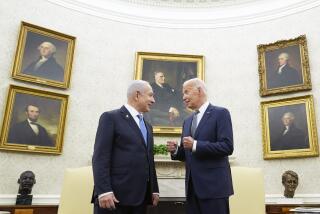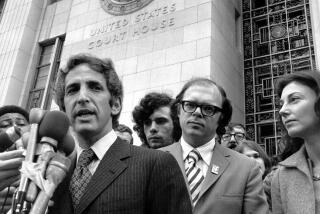Bitter Animosities in CIA Staff Revealed : Intelligence: Analyst complains that no expert data was sought before the sale of arms to Iran and diversion of the profits to Nicaragua’s Contras.
- Share via
WASHINGTON — A week after the Iran-Contra scandal was brought to light at a dramatic White House press conference in 1986, a senior career analyst at the CIA composed an extraordinary memo to his superior in which he vented his rage about a facet of the episode that had stunned him most.
The entire operation was based on assessments of political conditions in Iran, but no one had sought the intelligence compiled by the CIA team responsible for the region. That and related incidents “represent to me a perversion of the intelligence process staggering in its proportions,” wrote Thomas M. Barksdale, then the agency’s senior political analyst for Iran.
Barksdale’s memo to Richard Kerr, then the CIA’s deputy director for intelligence, is among newly declassified documents released Tuesday as U.S. senators continued to weigh the confirmation of Robert M. Gates to head the CIA.
The 1986 memo and other documents provide a rare view of bitter animosities and accusations of betrayal between career intelligence analysts and their CIA bosses that have become a central issue in the prolonged hearings before the Senate Intelligence Committee.
A similar record of dissent under Gates’ leadership at the agency was detailed in an internal report that summarized “working-level” CIA concerns that an assessment of the 1981 assassination attempt against Pope John Paul II reflected high-level biases.
The Dec. 2, 1986, memo by Barksdale, who still serves as one of the agency’s most highly respected analysts, said the CIA’s experts on Iran “were never consulted or asked to provide an intelligence input to the covert actions and secret contacts that have occurred” in connection with the Iran-Contra affair.
“In my judgment, this exclusion of expert opinion contributed significantly to the current foreign policy disaster,” Barksdale wrote.
It was not clear from Barksdale’s memo whether he was directing criticism at Gates, then deputy director of the agency. Gates has contended that he too was cut off from knowledge of key elements of the secret sales of arms to the Iranians and diversion of the proceeds to the Contras in Nicaragua.
But the criticism by agency officials of an intelligence assessment on the attempted assassination of Pope John Paul II directly involved Gates.
The April, 1985, report argued that the Soviet Union played a role in the shooting incident. The report was prepared under Gates’ direction and marked a sharp reversal from earlier CIA assessments. In a memorandum to then-Vice President George Bush, Gates championed the secret report and described it as the agency’s “first comprehensive examination” of the case.
But an internal CIA review of the assessment--titled “The Case for Soviet Involvement”--reported just three months later that its analysis was plagued by “serious shortcomings” and had failed to take into account “alternative explanations” that could have cast doubt on the theory implicating the KGB.
The review team found that Gates’ subordinates regarded the analysis as an unbalanced treatment that ran the risk of appearing biased. It blamed the one-sidedness of the report on efforts by analysts to draft a statement that would satisfy a CIA “senior management” that was believed to favor the view that the Soviets were involved.
The internal study also cited concern among the analysts that such a CIA agenda reflected an inappropriate deference within the agency to the strong views about the case held by Ronald Reagan Administration policy-makers.
The authors of the 22-page report said they found no evidence that either Gates, then the CIA’s deputy director for intelligence, or then-CIA chief William J. Casey personally directed that the study produce evidence of Soviet complicity.
But they blamed “stacking the deck” in an “unbalanced” assessment on efforts by officials within the intelligence directorate to “be responsive” to the “perceived desires” of Gates and Casey.
The newly declassified documents also disclose for the first time that Bush was among the senior Reagan Administration officials who asked the CIA for its opinion about possible Soviet involvement in the papal assassination attempt at a time when the agency had contended that the shooting was the work of a single gunman.
Bush requested in October, 1983, that the agency comment “on an article in an academic journal alleging that the Soviets had a strong motive for wanting the Pope killed,” the report said in citing a series of similar overtures.
The CIA response to that request, which would have been drafted by Gates’ directorate, was not among the documents declassified by the Senate Intelligence Committee. But in his April, 1985, cover letter to Bush, Gates presented the findings about the Soviet role as those the agency could now present “with some confidence.”
More to Read
Get the L.A. Times Politics newsletter
Deeply reported insights into legislation, politics and policy from Sacramento, Washington and beyond. In your inbox three times per week.
You may occasionally receive promotional content from the Los Angeles Times.










